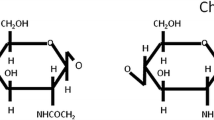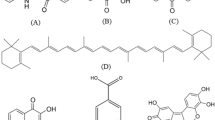Abstract
Carp species forms the bulk of the aquaculture production in India and studies have shown that the filleting waste of these species, particularly skin can be a good source of gelatin. This study is a comparison of the gelatins from these unexploited sources with that of mammalian gelatins to get a better understanding of their physicochemical and functional properties with respect to mammalian gelatins. The study showed that mammalian gelatins had significantly superior physical properties viz., higher viscosity, melting & setting temperature and faster setting time. The odour scores were significantly higher (P < 0.05) for bovine and porcine skin gelatins (3.1–3.12), indicating that they had a distinguishable odour and hence can be considered as inferior to fish skin gelatins in organoleptic qualities. The gel strengths of rohu and common carp skin gelatins were significantly lower than mammalian gelatins. Among the carp skin gelatins, grass carp skin gelatin was found to have better compatibility with gelatin from bovine and porcine skins.

Similar content being viewed by others
References
AOAC (1995) Official methods of analysis, 16th edn. Association of Official Analytical Chemists, Washington
Arnesen JA, Gildberg A (2002) Preparation and characterization of gelatin from the skin of harp seal (Phoca groenlandica). Bioresour Technol 82:191–194
Balian G, Bowes JH (1977) The structure and properties of collagen. In: Ward AG, Courts A (eds) The science and technology of gelatin. Academic Press, London, pp 1–31
BSI (British Standard Institution) (1975) Methods for sampling and testing gelatin (Physical and Chemical Methods), BSI, BS 757, London
Cho SM, Kwak KS, Park DC, Gu YS, Ji CI, Jang DH, Lee YB, Kim SB (2004) Processing optimization and functional properties of gelatin from shark (Isurus oxyrinchus) cartilage. Food Hydrocoll 18:573–579
Cho SM, Gu YS, Kim SB (2005) Extraction optimization and physical properties of yellowfin tuna (Thunnus albacares) skin gelatin compared to mammalian gelatins. Food Hydrocoll 19:221–229
Cho SH, Jahncke ML, Chin KB, Eun JB (2006) The effect of processing conditions on the properties of gelatin from skate (Raja kenojei) skins. Food Hydrocoll 20:810–816
Choi SS, Regenstein JM (2000) Physicochemical and sensory characteristics of fish gelatin. J Food Sci 65:194–199
Cole CGB (2000) Gelatin. In: Francis FJ (ed) Encyclopedia of food science and technology, 2, 2nd edn. Wiley, New York, pp 1183–1188
Eastoe JE, Eastoe B (1952) A method for the determination of total nitrogen in proteins. The British Gelatin and Glue Research Association Research Report, Series B 5:1–17
Eastoe JE, Leach AA (1977) Chemical constitution of gelatin. In: Ward AG, Courts A (eds) The science and technology of gelatin. Academic Press, London, pp 73–107
Galazka VB, Dickinson E, Ledward DA (1999) Emulsifying behavior of globulin Vicia faba in mixtures with sulphated polysaccharides: comparison of thermal and high-pressure treatments. Food Hydrocoll 13:425–435
George N, Joseph J, Zynudheen A (2010a) Preparation and characterization of gelatin extracted from the skins of rohu (Labeo Rohita) and common carp (Cyprinus Carpio). J Food Process Preserv 35(2):143–163
George N, Joseph J, Zynudheen A (2010b) Physical, mechanical, and barrier properties of carp and mammalian skin gelatin films. J Food Sci 75(9):E620–E626
Gilsenan PM, Ross-Murphy SB (2000) Rheological characterisation of gelatins from mammalian and marine sources. Food Hydrocoll 14:191–195
GME (2008) Gelatin manufacturers of Europe. http://www.gelatine.org/en/gelatine/overview/127.htm (accessed July 22, 2008)
Gomez-Guillen MC, Montero P (2001) Extraction of gelatin from megrim (Lepidorhombus boscii) skins with several organic acids. J Food Sci 66(2):213–216
Gomez-Guillen MC, Turnay J, Fernandez-Diaz MD, Ulmo N, Lizarbe MA, Montero P (2002) Structural and physical properties of gelatin extracted from different marine species: a comparative study. Food Hydrocoll 16:25–34
Grossman S, Bergman M (1992) Process for the production of gelatin from fish skins. US patent 5,093,474
Gudmundsson M (2002) Rheological properties of fish gelatin. J Food Sci 67:2172–2176
Gudmundsson M, Hafsteinsson H (1997) Gelatin from cod skins as affected by chemical treatments. J Food Sci 62:37–47
Holzer D (1996) Gelatin production. US Patent 5,484,888
Jamilah B, Harvinder KG (2002) Properties of gelatins from skins of fish-black tilapia (Oreochromis mossambicus) and red tilapia (Oreochromis nilotica). Food Chem 77:81–84
Jayathilakan K, Sultana K, Radhakrishna K, Bawa AS (2011) Utilization of byproducts and waste materials from meat, poultry and fish processing industries: a review. J Food Sci Technol. doi:10.1007/s13197-011-0290-7
Johnston-Banks FA (1990) Gelatin. In: Harris P (ed) Food gels. Elsevier Applied Sciences, New York, pp 233–289
Jongjareonrak A, Benjakul S, Visessanguan W, Tanaka M (2006) Skin gelatin from bigeye snapper and brownstripe red snapper: chemical compositions and effect of microbial transglutaminase on gel properties. Food Hydrocoll 20:1216–1222
Karim AA, Bhat R (2009) Fish gelatin: properties, challenges, and prospects as an alternative to mammalian gelatins. Food Hydrocoll 23:563–576
Kasankala LM, Xue Y, Weilong Y, Hong SD, He Q (2007) Optimization of gelatin extraction from grass carp (Ctenopharyngodon idella) fish skin by response surface methodology. Bioresour Technol 98:3338–3343
Kinsella JE (1977) Functional properties of protein: possible relationships between structure and function in foams. J Food Chem 7:273–288
Ledward DA (1986) Gelation of gelatin. In: Mitchell JR, Ledward DA (eds) Functional properties of food macromolecules. Elsevier Applied Science Publishers, London, pp 171–201
Lehninger AL, Nelson DL, Cox MM (1993) Three dimensional structure of proteins. In: Principles of Biochemistry, 2nd edn. Worth Publishers Inc., New York, pp 160–197
Leuenberger BH (1991) Investigation of viscosity and gelation properties of different mammalian and fish gelatins. Food Hydrocoll 5(4):353–361
Liu H, Li D, Guo S (2008) Rheological properties of channel catfish (Ictalurus punctatus) gelatin from fish skins preserved by different methods. LWT—Food Sci Technol 41:414–419
Muralidharan N, Jeya Shakila R, Sukumar D, Jeyasekaran G (2011) Skin, bone and muscle collagen extraction from the trash fish, leather jacket (Odonus niger) and their characterization. J Food Sci Technol. doi:10.1007/s13197-011-0440-y
Muyonga JH, Cole CGB, Duodu KG (2004) Extraction and physico-chemical characterisation of Nile perch (Lates niloticus) skin and bone gelatin. Food Hydrocoll 18:581–592
Nagai T, Suzuki N (2000) Isolation of collagen from fish waste material—skin, bone and fin. Food Chem 68:277–281
Piez KA, Gross G (1960) The amino acid composition of some fish collagens: The relation between composition and structure. J Biol Chem 235(4):995–998 (www.jbc.org accessed on February 6, 2012)
SAS (1989) Statistical analysis system for data analysis version 6. The SAS Institute, Cary
Sperling LH (2006) Introduction to physical polymer science, 4th edn. Wiley, NJ, ISBN 0-471-70606-X, 866p
Veis A (1964) The macromolecular chemistry of gelatin. Academic, New York, 433p
Wainewright FW (1977) Physical tests for gelatin and gel products. In: Ward AG, Courts A (eds) The science and technology of gelatins. Academic Press, London, pp 507–531
Acknowledgments
The authors are thankful to the Director, Central Institute of Fisheries Technology for according permission to publish the paper. The assistance rendered by the technical staff of the Fish Processing Division of the Institute is gratefully acknowledged.
Author information
Authors and Affiliations
Corresponding author
Rights and permissions
About this article
Cite this article
Ninan, G., Joseph, J. & Aliyamveettil, Z.A. A comparative study on the physical, chemical and functional properties of carp skin and mammalian gelatins. J Food Sci Technol 51, 2085–2091 (2014). https://doi.org/10.1007/s13197-012-0681-4
Revised:
Accepted:
Published:
Issue Date:
DOI: https://doi.org/10.1007/s13197-012-0681-4




